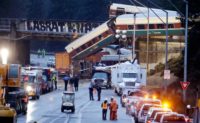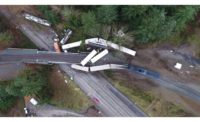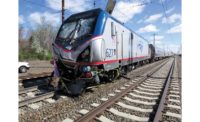The National Transportation Safety Board slammed Amtrak’s approach to safety management, charging that it spawned a host of deficiencies that led to the fatal 2016 derailment of a passenger train in Chester, Pa.
NTSB’s final report, issued on Nov. 14, identified 20 active failures of more than two dozen unsafe conditions—many involving safety-rule violations and risky behaviors by workers—that resulted in Amtrak train No. 89 being routed at high speed onto a track undergoing maintenance on April 3. The train, which was traveling at nearly 100 mph when it struck a backhoe, killed the operator and a track supervisor and injured 39 others.
Investigators found that supplemental shunting devices that would have indicated the maintenance crew’s presence within the signal system were not in place at the time of the accident, nor had they been issued to the work crew—a practice found to be common across Amtrak but not required by the Federal Railroad Administration.
Project foremen also failed to adequately communicate with dispatchers about the work taking place. Either measure likely would have prevented the accident, according to NTSB. Workers and contractors also did not receive a mandatory job briefing that might have alerted them to the absence of track protection devices.
Although the dead workers and locomotive engineer all tested positive for controlled substances, NTSB determined that the drug use, while not a contributor to the accident, was symptomatic of Amtrak’s weak safety culture.
“Clumsy Amtrak procedures seemed to encourage workarounds by workers to ‘get the job done,’ ” said NTSB Chairman Robert Sumwalt, adding that safety was further compromised by what he termed an “adversarial” management-labor relationship. “By focusing solely on compliance and punishment, Amtrak missed opportunities to improve safety through established, top-down safety management principles,” he pointed out. “They shut down the reporting of valuable safety information from their employees.”
The federal railroad agency’s failure to require redundant signal protection, such as shunts, was also cited as an accident contributor. Board member T. Bella Dinh-Zarr said the absence of shunts would have prevented Amtrak’s positive train control system, now being installed to meet a December 2018 deadline, from detecting the presence of the track workers. A requirement to outfit maintenance equipment with PTC technology was included among NTSB’s 14 recommendations provided to Amtrak, the agency and four railroad unions.






Post a comment to this article
Report Abusive Comment